Organisational Behaviour Report: Culture, Power, and Motivation
VerifiedAdded on 2020/10/23
|12
|3915
|310
Report
AI Summary
This report analyzes organisational behaviour within the context of 4com telecommunications, focusing on how organisational culture, power dynamics, and political influences impact individual and team performance. It evaluates various theories of motivation, including content and process theories such as Maslow's hierarchy of needs and goal-setting theory, and explores motivational techniques to achieve organisational goals. The report differentiates between effective and ineffective teams, highlighting the importance of interdependence and collaboration. It also examines the concepts and philosophies of organisational behaviour, including power structures (coercive, reward, legitimate, and referent) and the role of organisational politics. The analysis provides insights into how these elements affect employee behaviour and overall organisational success, emphasizing the importance of positive working environments and effective leadership in achieving objectives.
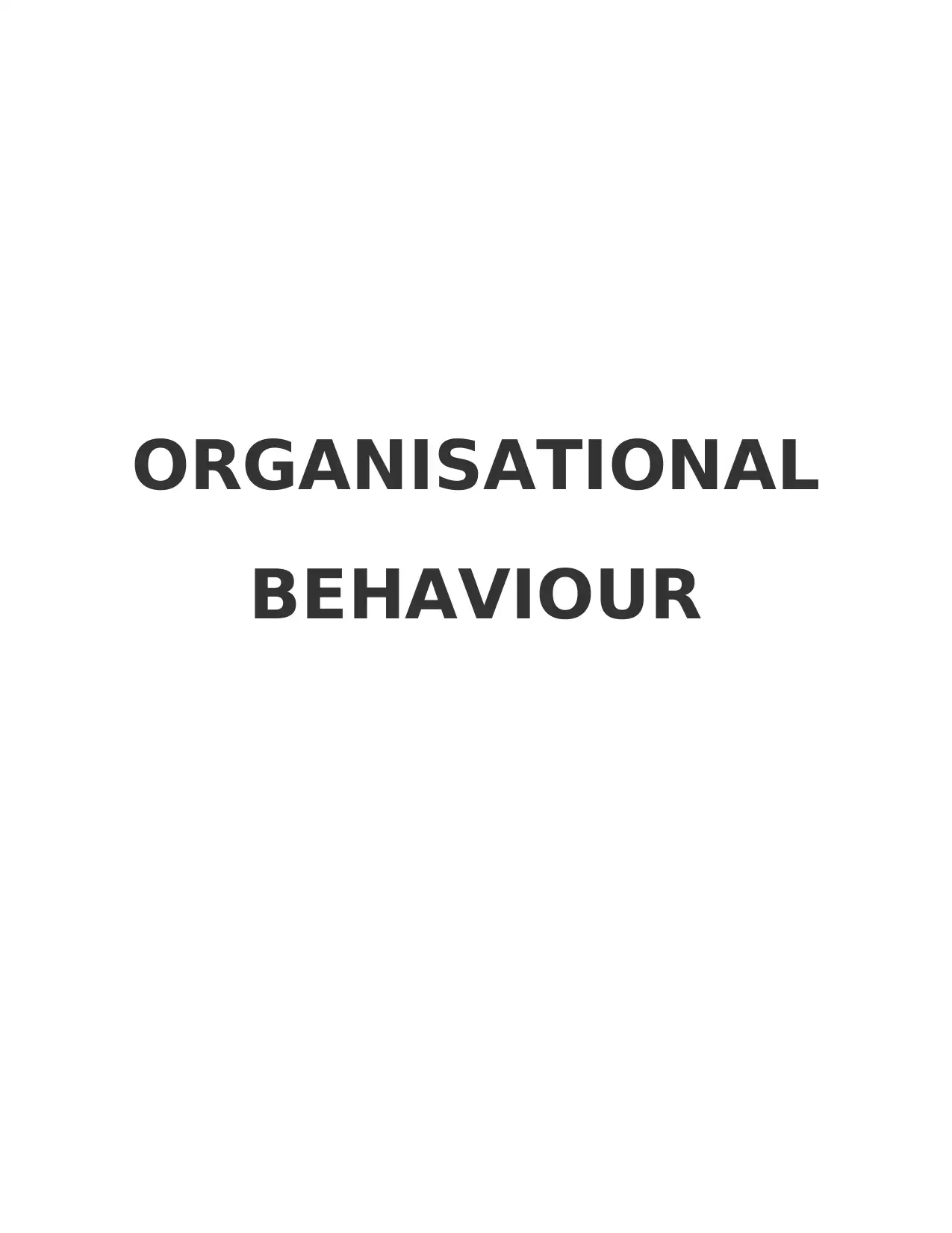
ORGANISATIONAL
BEHAVIOUR
BEHAVIOUR
Paraphrase This Document
Need a fresh take? Get an instant paraphrase of this document with our AI Paraphraser
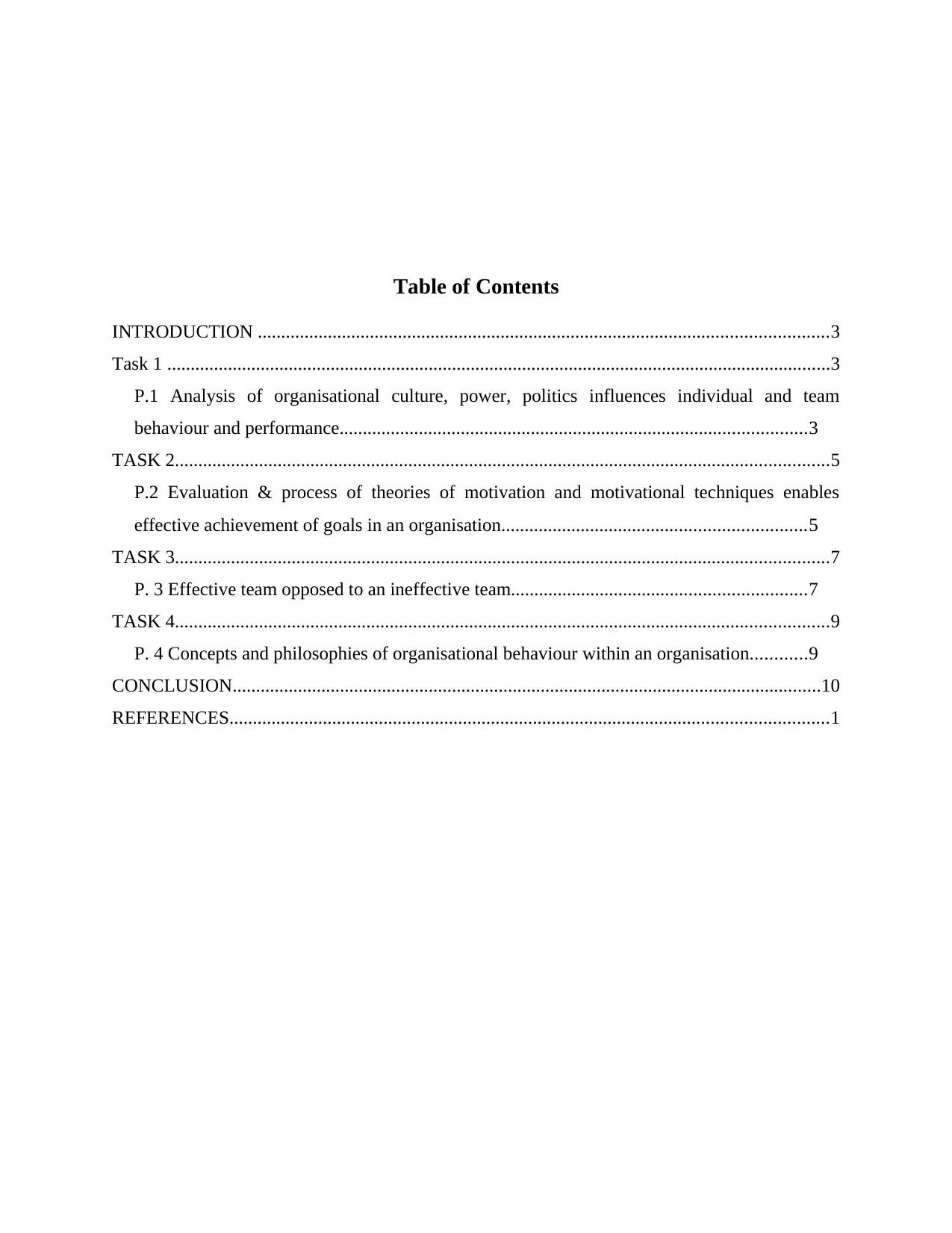
Table of Contents
INTRODUCTION ..........................................................................................................................3
Task 1 ..............................................................................................................................................3
P.1 Analysis of organisational culture, power, politics influences individual and team
behaviour and performance....................................................................................................3
TASK 2............................................................................................................................................5
P.2 Evaluation & process of theories of motivation and motivational techniques enables
effective achievement of goals in an organisation.................................................................5
TASK 3............................................................................................................................................7
P. 3 Effective team opposed to an ineffective team...............................................................7
TASK 4............................................................................................................................................9
P. 4 Concepts and philosophies of organisational behaviour within an organisation............9
CONCLUSION..............................................................................................................................10
REFERENCES................................................................................................................................1
INTRODUCTION ..........................................................................................................................3
Task 1 ..............................................................................................................................................3
P.1 Analysis of organisational culture, power, politics influences individual and team
behaviour and performance....................................................................................................3
TASK 2............................................................................................................................................5
P.2 Evaluation & process of theories of motivation and motivational techniques enables
effective achievement of goals in an organisation.................................................................5
TASK 3............................................................................................................................................7
P. 3 Effective team opposed to an ineffective team...............................................................7
TASK 4............................................................................................................................................9
P. 4 Concepts and philosophies of organisational behaviour within an organisation............9
CONCLUSION..............................................................................................................................10
REFERENCES................................................................................................................................1

INTRODUCTION
It's a process which understands, influence and predict the individual behaviour in setting
the organisational goals of an organisation. It is a basis of human resource management and it's
development. The principle applied to primarily in attempts as to make business work more
efficiently (Balmer and Burghausen, 2015). This report is based upon 4com telecommunication
company founded in 1999 based in UK, it's aim to improve the communication services of UK
SME market. This report includes the influence of culture, power and politics upon the
individual and performance of a team member and ways of motivation applied upon individual
so that goals of organisation can be achieved. The understanding of items which makes team
more effective in organisation, organisational philosophies applied to organisational behaviour in
a changing situation.
Task 1
P.1 Analysis of organisational culture, power, politics influences individual and team behaviour
and performance.
Organisational culture:- The culture is a important set of understanding which common
people share, consist of basic values, perceptions, idea, ideas etc. as which creates a different
impact upon human group. The organisation culture is set of system in which people share
beliefs and attitude that develop with in organisation or to guide behaviour of it's member. The
corporate culture consist of normal vales of organisation as well as management style, beliefs,
priorities and interpersonal behaviour that prevails to influence people as to communicate plan
and make decisions. The positive impact is when employees are treated equally in 4com nad
always satisfied with their job roles. The motivation level enhanced when organisation culture is
strong. The negative impact is when employees are behaviour is bad and creats conflicts between
employees (Bester, Stander and Van Zyl, 2015). The organisation culture model is Handy model
to analyse the certain culture which impact the individual as well a organisation behaviour and
performance. The cultures are:-
Power culture:- People who are able to influence others and they are just few peoples in
organisation who have these kind of power to influence others. Employees are judged by
It's a process which understands, influence and predict the individual behaviour in setting
the organisational goals of an organisation. It is a basis of human resource management and it's
development. The principle applied to primarily in attempts as to make business work more
efficiently (Balmer and Burghausen, 2015). This report is based upon 4com telecommunication
company founded in 1999 based in UK, it's aim to improve the communication services of UK
SME market. This report includes the influence of culture, power and politics upon the
individual and performance of a team member and ways of motivation applied upon individual
so that goals of organisation can be achieved. The understanding of items which makes team
more effective in organisation, organisational philosophies applied to organisational behaviour in
a changing situation.
Task 1
P.1 Analysis of organisational culture, power, politics influences individual and team behaviour
and performance.
Organisational culture:- The culture is a important set of understanding which common
people share, consist of basic values, perceptions, idea, ideas etc. as which creates a different
impact upon human group. The organisation culture is set of system in which people share
beliefs and attitude that develop with in organisation or to guide behaviour of it's member. The
corporate culture consist of normal vales of organisation as well as management style, beliefs,
priorities and interpersonal behaviour that prevails to influence people as to communicate plan
and make decisions. The positive impact is when employees are treated equally in 4com nad
always satisfied with their job roles. The motivation level enhanced when organisation culture is
strong. The negative impact is when employees are behaviour is bad and creats conflicts between
employees (Bester, Stander and Van Zyl, 2015). The organisation culture model is Handy model
to analyse the certain culture which impact the individual as well a organisation behaviour and
performance. The cultures are:-
Power culture:- People who are able to influence others and they are just few peoples in
organisation who have these kind of power to influence others. Employees are judged by
⊘ This is a preview!⊘
Do you want full access?
Subscribe today to unlock all pages.

Trusted by 1+ million students worldwide
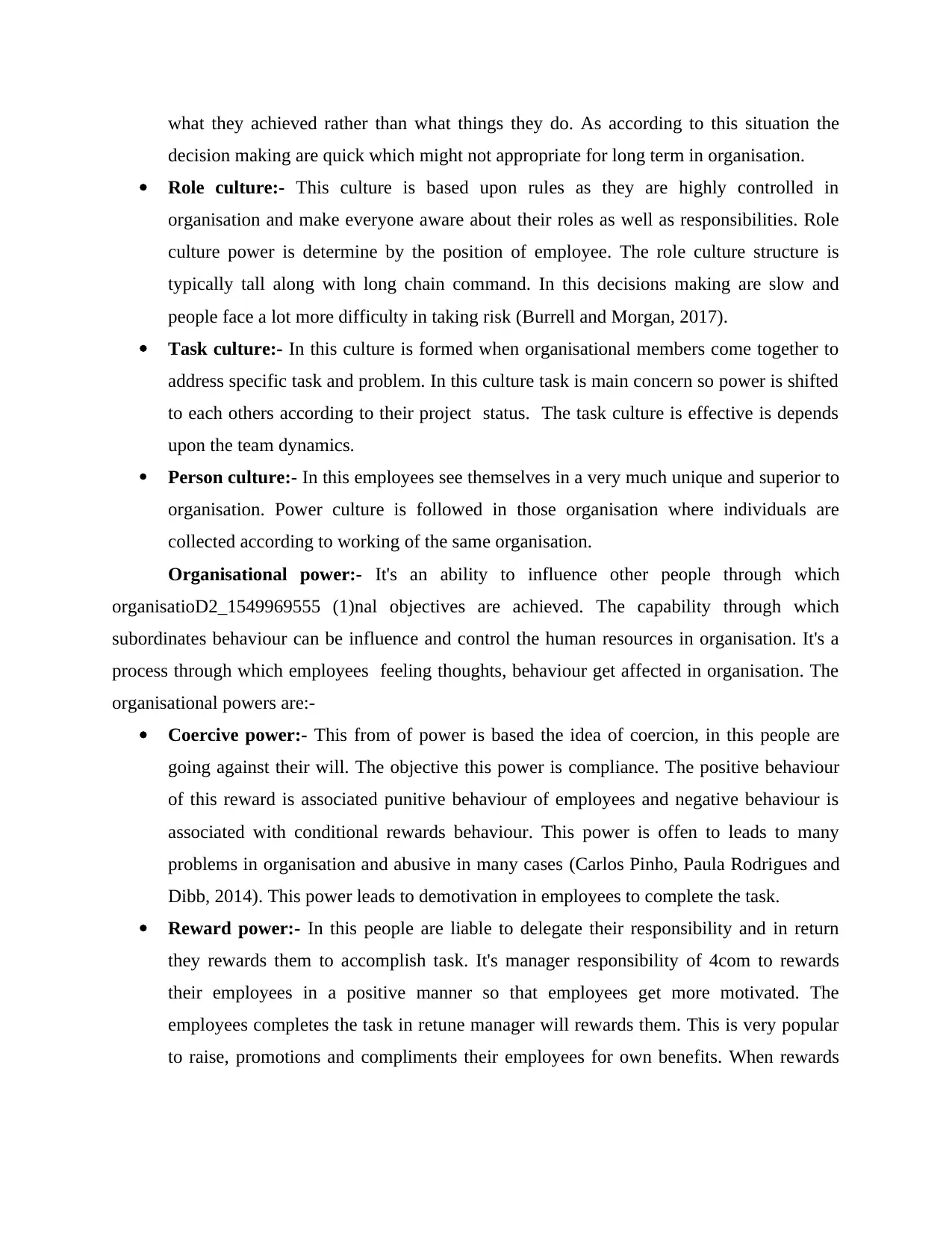
what they achieved rather than what things they do. As according to this situation the
decision making are quick which might not appropriate for long term in organisation.
Role culture:- This culture is based upon rules as they are highly controlled in
organisation and make everyone aware about their roles as well as responsibilities. Role
culture power is determine by the position of employee. The role culture structure is
typically tall along with long chain command. In this decisions making are slow and
people face a lot more difficulty in taking risk (Burrell and Morgan, 2017).
Task culture:- In this culture is formed when organisational members come together to
address specific task and problem. In this culture task is main concern so power is shifted
to each others according to their project status. The task culture is effective is depends
upon the team dynamics.
Person culture:- In this employees see themselves in a very much unique and superior to
organisation. Power culture is followed in those organisation where individuals are
collected according to working of the same organisation.
Organisational power:- It's an ability to influence other people through which
organisatioD2_1549969555 (1)nal objectives are achieved. The capability through which
subordinates behaviour can be influence and control the human resources in organisation. It's a
process through which employees feeling thoughts, behaviour get affected in organisation. The
organisational powers are:-
Coercive power:- This from of power is based the idea of coercion, in this people are
going against their will. The objective this power is compliance. The positive behaviour
of this reward is associated punitive behaviour of employees and negative behaviour is
associated with conditional rewards behaviour. This power is offen to leads to many
problems in organisation and abusive in many cases (Carlos Pinho, Paula Rodrigues and
Dibb, 2014). This power leads to demotivation in employees to complete the task.
Reward power:- In this people are liable to delegate their responsibility and in return
they rewards them to accomplish task. It's manager responsibility of 4com to rewards
their employees in a positive manner so that employees get more motivated. The
employees completes the task in retune manager will rewards them. This is very popular
to raise, promotions and compliments their employees for own benefits. When rewards
decision making are quick which might not appropriate for long term in organisation.
Role culture:- This culture is based upon rules as they are highly controlled in
organisation and make everyone aware about their roles as well as responsibilities. Role
culture power is determine by the position of employee. The role culture structure is
typically tall along with long chain command. In this decisions making are slow and
people face a lot more difficulty in taking risk (Burrell and Morgan, 2017).
Task culture:- In this culture is formed when organisational members come together to
address specific task and problem. In this culture task is main concern so power is shifted
to each others according to their project status. The task culture is effective is depends
upon the team dynamics.
Person culture:- In this employees see themselves in a very much unique and superior to
organisation. Power culture is followed in those organisation where individuals are
collected according to working of the same organisation.
Organisational power:- It's an ability to influence other people through which
organisatioD2_1549969555 (1)nal objectives are achieved. The capability through which
subordinates behaviour can be influence and control the human resources in organisation. It's a
process through which employees feeling thoughts, behaviour get affected in organisation. The
organisational powers are:-
Coercive power:- This from of power is based the idea of coercion, in this people are
going against their will. The objective this power is compliance. The positive behaviour
of this reward is associated punitive behaviour of employees and negative behaviour is
associated with conditional rewards behaviour. This power is offen to leads to many
problems in organisation and abusive in many cases (Carlos Pinho, Paula Rodrigues and
Dibb, 2014). This power leads to demotivation in employees to complete the task.
Reward power:- In this people are liable to delegate their responsibility and in return
they rewards them to accomplish task. It's manager responsibility of 4com to rewards
their employees in a positive manner so that employees get more motivated. The
employees completes the task in retune manager will rewards them. This is very popular
to raise, promotions and compliments their employees for own benefits. When rewards
Paraphrase This Document
Need a fresh take? Get an instant paraphrase of this document with our AI Paraphraser

are not efficient as compare to people who have done the work then it become difficult
for people to anticipate this power.
Legitimate power:- In this employees are allow to link the situations with obligated
feeling and notions of responsibility to management. In this employees are reward as well
as gets punished by leaders of 4com for completing or not completing the task. This
power is weak when it's comes to persuade and influence employees.
Referent power:- In this form of power which is based upon certain approval and
acceptance. This power is treated as administration and charm, as they are treated as role
model in organisation (Coccia, 2014).
Organisational politics:- In this politics are informal, sometimes behind the scene and
unofficial efforts to sell ideas, increase power, achieved other targeted objectives and influence
an organisation. In organisation it's very essential to understand the conflicts agendas and shifts
power according to skills. The organisation have to understand this otherwise appropriate
delegation of responsibilities can't be implemented. The politics is not about having appropriate
cost control but it's about to maintaining relationships with employees. The organisational
politics is not bad but it's essential to have as to minimise the negative impact in organisation.
The effective politics is run by 4com manager so that they are able to implement effective
changes in organisation. The positive impact is employees are delegated with power then politics
is not required as to achieve the certain objectives. Negative impact is when it's increased in
organisation then employees become more violent and due to this conflicts are also raised in
organisation.
TASK 2
P.2 Evaluation & process of theories of motivation and motivational techniques enables effective
achievement of goals in an organisation.
The motivations is process through which employees of an organisation start doing work
to accomplish objectives of 4com. The company aim is to telecom services to SEM in UK
market, so it's become important for them to motivate their employees so that companies aim can
be fulfilled (Elsmore, 2017). The employees can be motivated through monetary benefits as well
as non-monetary benefits. The content and process motivational theory and techniques are:-
for people to anticipate this power.
Legitimate power:- In this employees are allow to link the situations with obligated
feeling and notions of responsibility to management. In this employees are reward as well
as gets punished by leaders of 4com for completing or not completing the task. This
power is weak when it's comes to persuade and influence employees.
Referent power:- In this form of power which is based upon certain approval and
acceptance. This power is treated as administration and charm, as they are treated as role
model in organisation (Coccia, 2014).
Organisational politics:- In this politics are informal, sometimes behind the scene and
unofficial efforts to sell ideas, increase power, achieved other targeted objectives and influence
an organisation. In organisation it's very essential to understand the conflicts agendas and shifts
power according to skills. The organisation have to understand this otherwise appropriate
delegation of responsibilities can't be implemented. The politics is not about having appropriate
cost control but it's about to maintaining relationships with employees. The organisational
politics is not bad but it's essential to have as to minimise the negative impact in organisation.
The effective politics is run by 4com manager so that they are able to implement effective
changes in organisation. The positive impact is employees are delegated with power then politics
is not required as to achieve the certain objectives. Negative impact is when it's increased in
organisation then employees become more violent and due to this conflicts are also raised in
organisation.
TASK 2
P.2 Evaluation & process of theories of motivation and motivational techniques enables effective
achievement of goals in an organisation.
The motivations is process through which employees of an organisation start doing work
to accomplish objectives of 4com. The company aim is to telecom services to SEM in UK
market, so it's become important for them to motivate their employees so that companies aim can
be fulfilled (Elsmore, 2017). The employees can be motivated through monetary benefits as well
as non-monetary benefits. The content and process motivational theory and techniques are:-
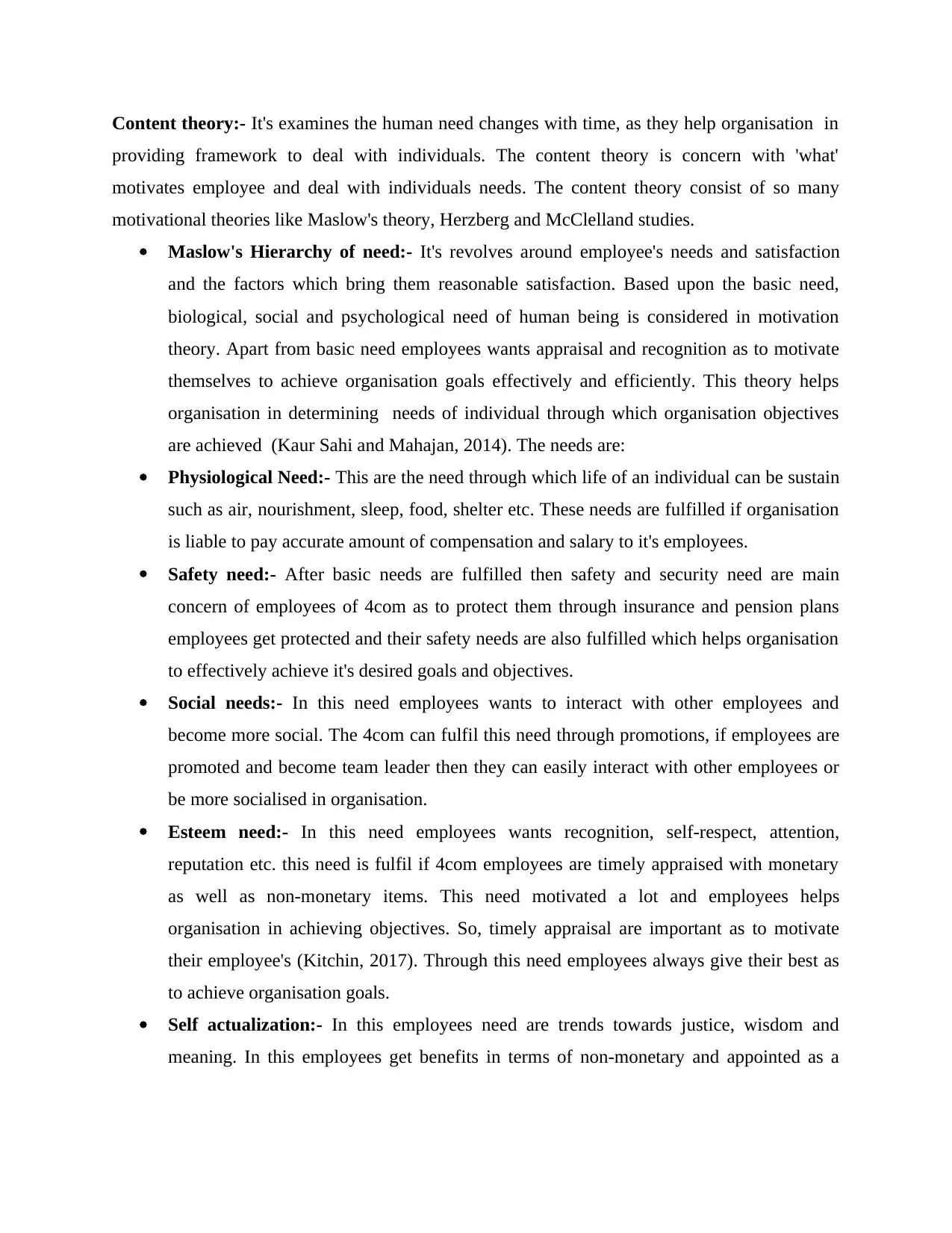
Content theory:- It's examines the human need changes with time, as they help organisation in
providing framework to deal with individuals. The content theory is concern with 'what'
motivates employee and deal with individuals needs. The content theory consist of so many
motivational theories like Maslow's theory, Herzberg and McClelland studies.
Maslow's Hierarchy of need:- It's revolves around employee's needs and satisfaction
and the factors which bring them reasonable satisfaction. Based upon the basic need,
biological, social and psychological need of human being is considered in motivation
theory. Apart from basic need employees wants appraisal and recognition as to motivate
themselves to achieve organisation goals effectively and efficiently. This theory helps
organisation in determining needs of individual through which organisation objectives
are achieved (Kaur Sahi and Mahajan, 2014). The needs are:
Physiological Need:- This are the need through which life of an individual can be sustain
such as air, nourishment, sleep, food, shelter etc. These needs are fulfilled if organisation
is liable to pay accurate amount of compensation and salary to it's employees.
Safety need:- After basic needs are fulfilled then safety and security need are main
concern of employees of 4com as to protect them through insurance and pension plans
employees get protected and their safety needs are also fulfilled which helps organisation
to effectively achieve it's desired goals and objectives.
Social needs:- In this need employees wants to interact with other employees and
become more social. The 4com can fulfil this need through promotions, if employees are
promoted and become team leader then they can easily interact with other employees or
be more socialised in organisation.
Esteem need:- In this need employees wants recognition, self-respect, attention,
reputation etc. this need is fulfil if 4com employees are timely appraised with monetary
as well as non-monetary items. This need motivated a lot and employees helps
organisation in achieving objectives. So, timely appraisal are important as to motivate
their employee's (Kitchin, 2017). Through this need employees always give their best as
to achieve organisation goals.
Self actualization:- In this employees need are trends towards justice, wisdom and
meaning. In this employees get benefits in terms of non-monetary and appointed as a
providing framework to deal with individuals. The content theory is concern with 'what'
motivates employee and deal with individuals needs. The content theory consist of so many
motivational theories like Maslow's theory, Herzberg and McClelland studies.
Maslow's Hierarchy of need:- It's revolves around employee's needs and satisfaction
and the factors which bring them reasonable satisfaction. Based upon the basic need,
biological, social and psychological need of human being is considered in motivation
theory. Apart from basic need employees wants appraisal and recognition as to motivate
themselves to achieve organisation goals effectively and efficiently. This theory helps
organisation in determining needs of individual through which organisation objectives
are achieved (Kaur Sahi and Mahajan, 2014). The needs are:
Physiological Need:- This are the need through which life of an individual can be sustain
such as air, nourishment, sleep, food, shelter etc. These needs are fulfilled if organisation
is liable to pay accurate amount of compensation and salary to it's employees.
Safety need:- After basic needs are fulfilled then safety and security need are main
concern of employees of 4com as to protect them through insurance and pension plans
employees get protected and their safety needs are also fulfilled which helps organisation
to effectively achieve it's desired goals and objectives.
Social needs:- In this need employees wants to interact with other employees and
become more social. The 4com can fulfil this need through promotions, if employees are
promoted and become team leader then they can easily interact with other employees or
be more socialised in organisation.
Esteem need:- In this need employees wants recognition, self-respect, attention,
reputation etc. this need is fulfil if 4com employees are timely appraised with monetary
as well as non-monetary items. This need motivated a lot and employees helps
organisation in achieving objectives. So, timely appraisal are important as to motivate
their employee's (Kitchin, 2017). Through this need employees always give their best as
to achieve organisation goals.
Self actualization:- In this employees need are trends towards justice, wisdom and
meaning. In this employees get benefits in terms of non-monetary and appointed as a
⊘ This is a preview!⊘
Do you want full access?
Subscribe today to unlock all pages.

Trusted by 1+ million students worldwide
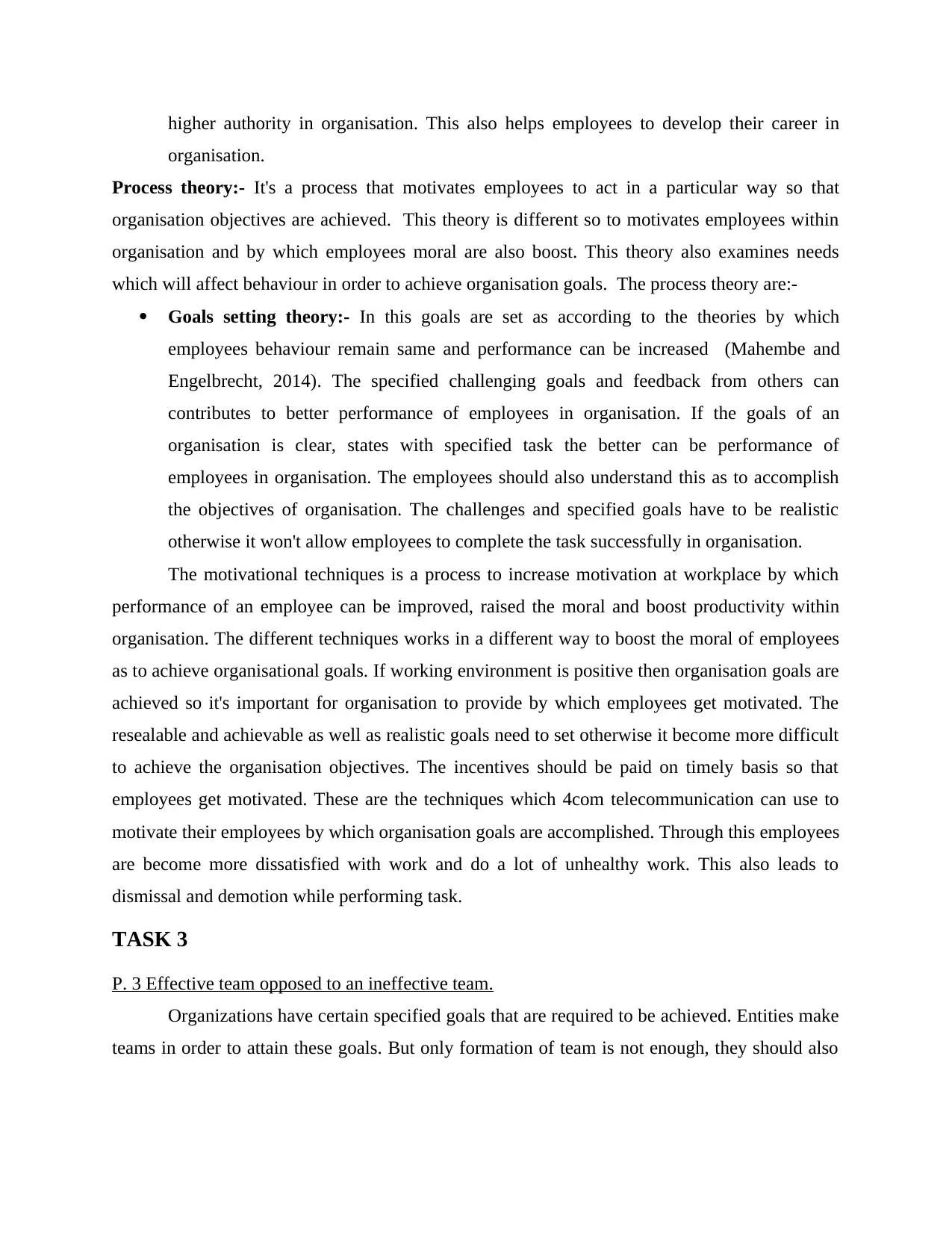
higher authority in organisation. This also helps employees to develop their career in
organisation.
Process theory:- It's a process that motivates employees to act in a particular way so that
organisation objectives are achieved. This theory is different so to motivates employees within
organisation and by which employees moral are also boost. This theory also examines needs
which will affect behaviour in order to achieve organisation goals. The process theory are:-
Goals setting theory:- In this goals are set as according to the theories by which
employees behaviour remain same and performance can be increased (Mahembe and
Engelbrecht, 2014). The specified challenging goals and feedback from others can
contributes to better performance of employees in organisation. If the goals of an
organisation is clear, states with specified task the better can be performance of
employees in organisation. The employees should also understand this as to accomplish
the objectives of organisation. The challenges and specified goals have to be realistic
otherwise it won't allow employees to complete the task successfully in organisation.
The motivational techniques is a process to increase motivation at workplace by which
performance of an employee can be improved, raised the moral and boost productivity within
organisation. The different techniques works in a different way to boost the moral of employees
as to achieve organisational goals. If working environment is positive then organisation goals are
achieved so it's important for organisation to provide by which employees get motivated. The
resealable and achievable as well as realistic goals need to set otherwise it become more difficult
to achieve the organisation objectives. The incentives should be paid on timely basis so that
employees get motivated. These are the techniques which 4com telecommunication can use to
motivate their employees by which organisation goals are accomplished. Through this employees
are become more dissatisfied with work and do a lot of unhealthy work. This also leads to
dismissal and demotion while performing task.
TASK 3
P. 3 Effective team opposed to an ineffective team.
Organizations have certain specified goals that are required to be achieved. Entities make
teams in order to attain these goals. But only formation of team is not enough, they should also
organisation.
Process theory:- It's a process that motivates employees to act in a particular way so that
organisation objectives are achieved. This theory is different so to motivates employees within
organisation and by which employees moral are also boost. This theory also examines needs
which will affect behaviour in order to achieve organisation goals. The process theory are:-
Goals setting theory:- In this goals are set as according to the theories by which
employees behaviour remain same and performance can be increased (Mahembe and
Engelbrecht, 2014). The specified challenging goals and feedback from others can
contributes to better performance of employees in organisation. If the goals of an
organisation is clear, states with specified task the better can be performance of
employees in organisation. The employees should also understand this as to accomplish
the objectives of organisation. The challenges and specified goals have to be realistic
otherwise it won't allow employees to complete the task successfully in organisation.
The motivational techniques is a process to increase motivation at workplace by which
performance of an employee can be improved, raised the moral and boost productivity within
organisation. The different techniques works in a different way to boost the moral of employees
as to achieve organisational goals. If working environment is positive then organisation goals are
achieved so it's important for organisation to provide by which employees get motivated. The
resealable and achievable as well as realistic goals need to set otherwise it become more difficult
to achieve the organisation objectives. The incentives should be paid on timely basis so that
employees get motivated. These are the techniques which 4com telecommunication can use to
motivate their employees by which organisation goals are accomplished. Through this employees
are become more dissatisfied with work and do a lot of unhealthy work. This also leads to
dismissal and demotion while performing task.
TASK 3
P. 3 Effective team opposed to an ineffective team.
Organizations have certain specified goals that are required to be achieved. Entities make
teams in order to attain these goals. But only formation of team is not enough, they should also
Paraphrase This Document
Need a fresh take? Get an instant paraphrase of this document with our AI Paraphraser
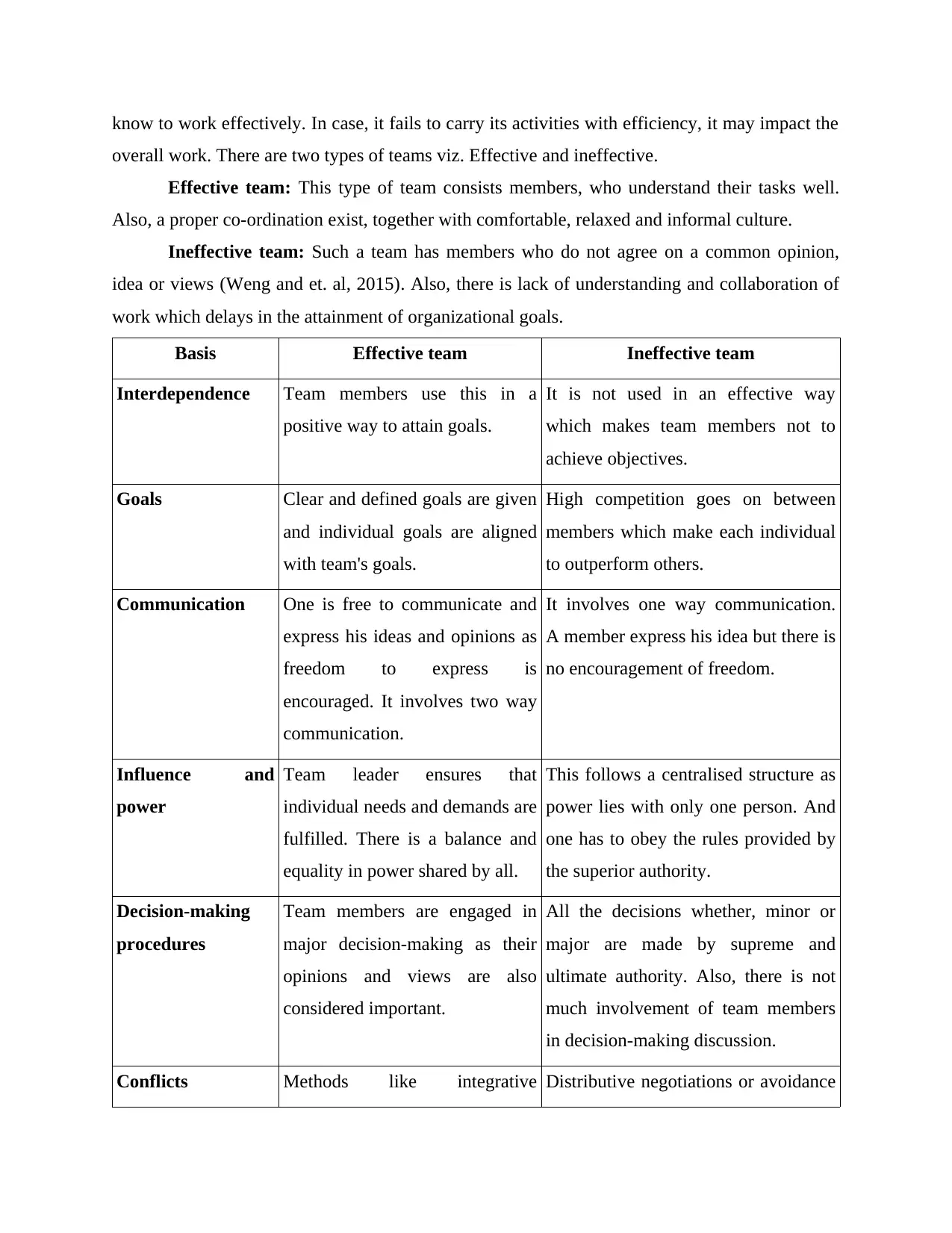
know to work effectively. In case, it fails to carry its activities with efficiency, it may impact the
overall work. There are two types of teams viz. Effective and ineffective.
Effective team: This type of team consists members, who understand their tasks well.
Also, a proper co-ordination exist, together with comfortable, relaxed and informal culture.
Ineffective team: Such a team has members who do not agree on a common opinion,
idea or views (Weng and et. al, 2015). Also, there is lack of understanding and collaboration of
work which delays in the attainment of organizational goals.
Basis Effective team Ineffective team
Interdependence Team members use this in a
positive way to attain goals.
It is not used in an effective way
which makes team members not to
achieve objectives.
Goals Clear and defined goals are given
and individual goals are aligned
with team's goals.
High competition goes on between
members which make each individual
to outperform others.
Communication One is free to communicate and
express his ideas and opinions as
freedom to express is
encouraged. It involves two way
communication.
It involves one way communication.
A member express his idea but there is
no encouragement of freedom.
Influence and
power
Team leader ensures that
individual needs and demands are
fulfilled. There is a balance and
equality in power shared by all.
This follows a centralised structure as
power lies with only one person. And
one has to obey the rules provided by
the superior authority.
Decision-making
procedures
Team members are engaged in
major decision-making as their
opinions and views are also
considered important.
All the decisions whether, minor or
major are made by supreme and
ultimate authority. Also, there is not
much involvement of team members
in decision-making discussion.
Conflicts Methods like integrative Distributive negotiations or avoidance
overall work. There are two types of teams viz. Effective and ineffective.
Effective team: This type of team consists members, who understand their tasks well.
Also, a proper co-ordination exist, together with comfortable, relaxed and informal culture.
Ineffective team: Such a team has members who do not agree on a common opinion,
idea or views (Weng and et. al, 2015). Also, there is lack of understanding and collaboration of
work which delays in the attainment of organizational goals.
Basis Effective team Ineffective team
Interdependence Team members use this in a
positive way to attain goals.
It is not used in an effective way
which makes team members not to
achieve objectives.
Goals Clear and defined goals are given
and individual goals are aligned
with team's goals.
High competition goes on between
members which make each individual
to outperform others.
Communication One is free to communicate and
express his ideas and opinions as
freedom to express is
encouraged. It involves two way
communication.
It involves one way communication.
A member express his idea but there is
no encouragement of freedom.
Influence and
power
Team leader ensures that
individual needs and demands are
fulfilled. There is a balance and
equality in power shared by all.
This follows a centralised structure as
power lies with only one person. And
one has to obey the rules provided by
the superior authority.
Decision-making
procedures
Team members are engaged in
major decision-making as their
opinions and views are also
considered important.
All the decisions whether, minor or
major are made by supreme and
ultimate authority. Also, there is not
much involvement of team members
in decision-making discussion.
Conflicts Methods like integrative Distributive negotiations or avoidance
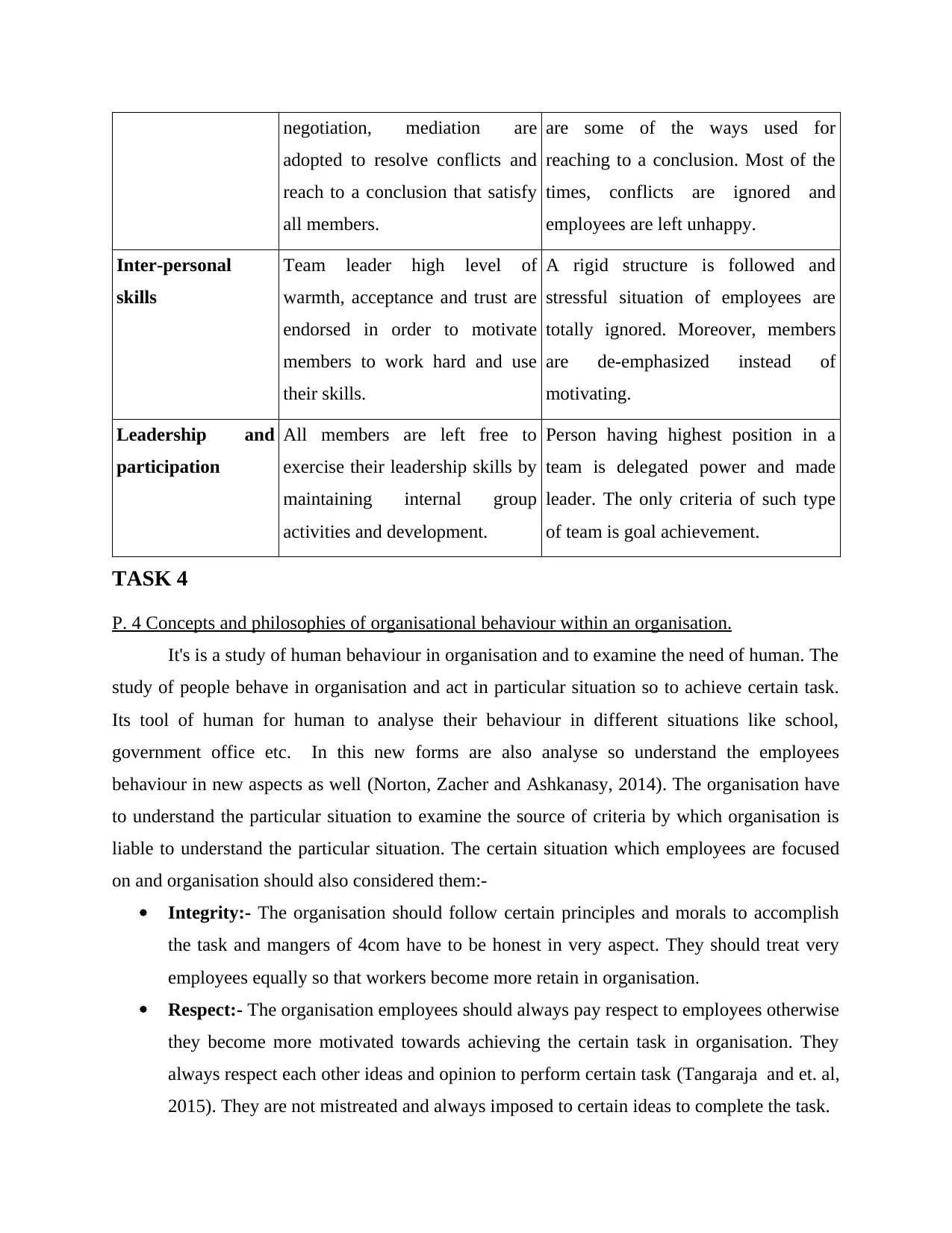
negotiation, mediation are
adopted to resolve conflicts and
reach to a conclusion that satisfy
all members.
are some of the ways used for
reaching to a conclusion. Most of the
times, conflicts are ignored and
employees are left unhappy.
Inter-personal
skills
Team leader high level of
warmth, acceptance and trust are
endorsed in order to motivate
members to work hard and use
their skills.
A rigid structure is followed and
stressful situation of employees are
totally ignored. Moreover, members
are de-emphasized instead of
motivating.
Leadership and
participation
All members are left free to
exercise their leadership skills by
maintaining internal group
activities and development.
Person having highest position in a
team is delegated power and made
leader. The only criteria of such type
of team is goal achievement.
TASK 4
P. 4 Concepts and philosophies of organisational behaviour within an organisation.
It's is a study of human behaviour in organisation and to examine the need of human. The
study of people behave in organisation and act in particular situation so to achieve certain task.
Its tool of human for human to analyse their behaviour in different situations like school,
government office etc. In this new forms are also analyse so understand the employees
behaviour in new aspects as well (Norton, Zacher and Ashkanasy, 2014). The organisation have
to understand the particular situation to examine the source of criteria by which organisation is
liable to understand the particular situation. The certain situation which employees are focused
on and organisation should also considered them:-
Integrity:- The organisation should follow certain principles and morals to accomplish
the task and mangers of 4com have to be honest in very aspect. They should treat very
employees equally so that workers become more retain in organisation.
Respect:- The organisation employees should always pay respect to employees otherwise
they become more motivated towards achieving the certain task in organisation. They
always respect each other ideas and opinion to perform certain task (Tangaraja and et. al,
2015). They are not mistreated and always imposed to certain ideas to complete the task.
adopted to resolve conflicts and
reach to a conclusion that satisfy
all members.
are some of the ways used for
reaching to a conclusion. Most of the
times, conflicts are ignored and
employees are left unhappy.
Inter-personal
skills
Team leader high level of
warmth, acceptance and trust are
endorsed in order to motivate
members to work hard and use
their skills.
A rigid structure is followed and
stressful situation of employees are
totally ignored. Moreover, members
are de-emphasized instead of
motivating.
Leadership and
participation
All members are left free to
exercise their leadership skills by
maintaining internal group
activities and development.
Person having highest position in a
team is delegated power and made
leader. The only criteria of such type
of team is goal achievement.
TASK 4
P. 4 Concepts and philosophies of organisational behaviour within an organisation.
It's is a study of human behaviour in organisation and to examine the need of human. The
study of people behave in organisation and act in particular situation so to achieve certain task.
Its tool of human for human to analyse their behaviour in different situations like school,
government office etc. In this new forms are also analyse so understand the employees
behaviour in new aspects as well (Norton, Zacher and Ashkanasy, 2014). The organisation have
to understand the particular situation to examine the source of criteria by which organisation is
liable to understand the particular situation. The certain situation which employees are focused
on and organisation should also considered them:-
Integrity:- The organisation should follow certain principles and morals to accomplish
the task and mangers of 4com have to be honest in very aspect. They should treat very
employees equally so that workers become more retain in organisation.
Respect:- The organisation employees should always pay respect to employees otherwise
they become more motivated towards achieving the certain task in organisation. They
always respect each other ideas and opinion to perform certain task (Tangaraja and et. al,
2015). They are not mistreated and always imposed to certain ideas to complete the task.
⊘ This is a preview!⊘
Do you want full access?
Subscribe today to unlock all pages.

Trusted by 1+ million students worldwide
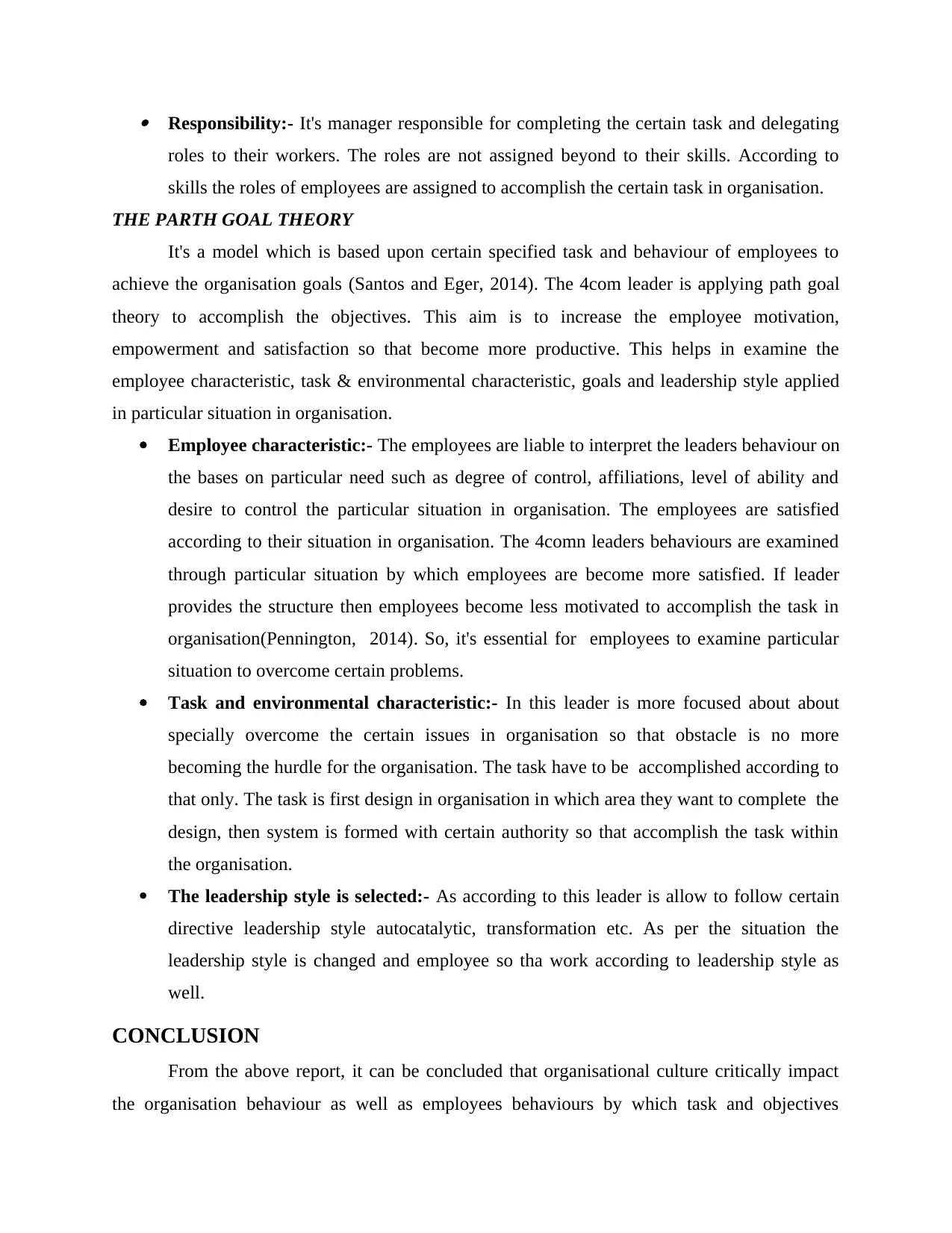
Responsibility:- It's manager responsible for completing the certain task and delegating
roles to their workers. The roles are not assigned beyond to their skills. According to
skills the roles of employees are assigned to accomplish the certain task in organisation.
THE PARTH GOAL THEORY
It's a model which is based upon certain specified task and behaviour of employees to
achieve the organisation goals (Santos and Eger, 2014). The 4com leader is applying path goal
theory to accomplish the objectives. This aim is to increase the employee motivation,
empowerment and satisfaction so that become more productive. This helps in examine the
employee characteristic, task & environmental characteristic, goals and leadership style applied
in particular situation in organisation.
Employee characteristic:- The employees are liable to interpret the leaders behaviour on
the bases on particular need such as degree of control, affiliations, level of ability and
desire to control the particular situation in organisation. The employees are satisfied
according to their situation in organisation. The 4comn leaders behaviours are examined
through particular situation by which employees are become more satisfied. If leader
provides the structure then employees become less motivated to accomplish the task in
organisation(Pennington, 2014). So, it's essential for employees to examine particular
situation to overcome certain problems.
Task and environmental characteristic:- In this leader is more focused about about
specially overcome the certain issues in organisation so that obstacle is no more
becoming the hurdle for the organisation. The task have to be accomplished according to
that only. The task is first design in organisation in which area they want to complete the
design, then system is formed with certain authority so that accomplish the task within
the organisation.
The leadership style is selected:- As according to this leader is allow to follow certain
directive leadership style autocatalytic, transformation etc. As per the situation the
leadership style is changed and employee so tha work according to leadership style as
well.
CONCLUSION
From the above report, it can be concluded that organisational culture critically impact
the organisation behaviour as well as employees behaviours by which task and objectives
roles to their workers. The roles are not assigned beyond to their skills. According to
skills the roles of employees are assigned to accomplish the certain task in organisation.
THE PARTH GOAL THEORY
It's a model which is based upon certain specified task and behaviour of employees to
achieve the organisation goals (Santos and Eger, 2014). The 4com leader is applying path goal
theory to accomplish the objectives. This aim is to increase the employee motivation,
empowerment and satisfaction so that become more productive. This helps in examine the
employee characteristic, task & environmental characteristic, goals and leadership style applied
in particular situation in organisation.
Employee characteristic:- The employees are liable to interpret the leaders behaviour on
the bases on particular need such as degree of control, affiliations, level of ability and
desire to control the particular situation in organisation. The employees are satisfied
according to their situation in organisation. The 4comn leaders behaviours are examined
through particular situation by which employees are become more satisfied. If leader
provides the structure then employees become less motivated to accomplish the task in
organisation(Pennington, 2014). So, it's essential for employees to examine particular
situation to overcome certain problems.
Task and environmental characteristic:- In this leader is more focused about about
specially overcome the certain issues in organisation so that obstacle is no more
becoming the hurdle for the organisation. The task have to be accomplished according to
that only. The task is first design in organisation in which area they want to complete the
design, then system is formed with certain authority so that accomplish the task within
the organisation.
The leadership style is selected:- As according to this leader is allow to follow certain
directive leadership style autocatalytic, transformation etc. As per the situation the
leadership style is changed and employee so tha work according to leadership style as
well.
CONCLUSION
From the above report, it can be concluded that organisational culture critically impact
the organisation behaviour as well as employees behaviours by which task and objectives
Paraphrase This Document
Need a fresh take? Get an instant paraphrase of this document with our AI Paraphraser

accomplishment become difficult. The power should be delegated accordingly otherwise it
would become difficult to influence employees in the organisation. The power is important but
politics is not important to accomplished the task within organisation. The content theory is
applied to understand the motivation of employees and also understands the process theory by
which employees accomplish the task in organisation. The team effectiveness is examined with
the help of organisation ineffective team. The path goal theory is applied in organisation so that
they are been able to examine the situation of organisation and employees behaviour.
would become difficult to influence employees in the organisation. The power is important but
politics is not important to accomplished the task within organisation. The content theory is
applied to understand the motivation of employees and also understands the process theory by
which employees accomplish the task in organisation. The team effectiveness is examined with
the help of organisation ineffective team. The path goal theory is applied in organisation so that
they are been able to examine the situation of organisation and employees behaviour.
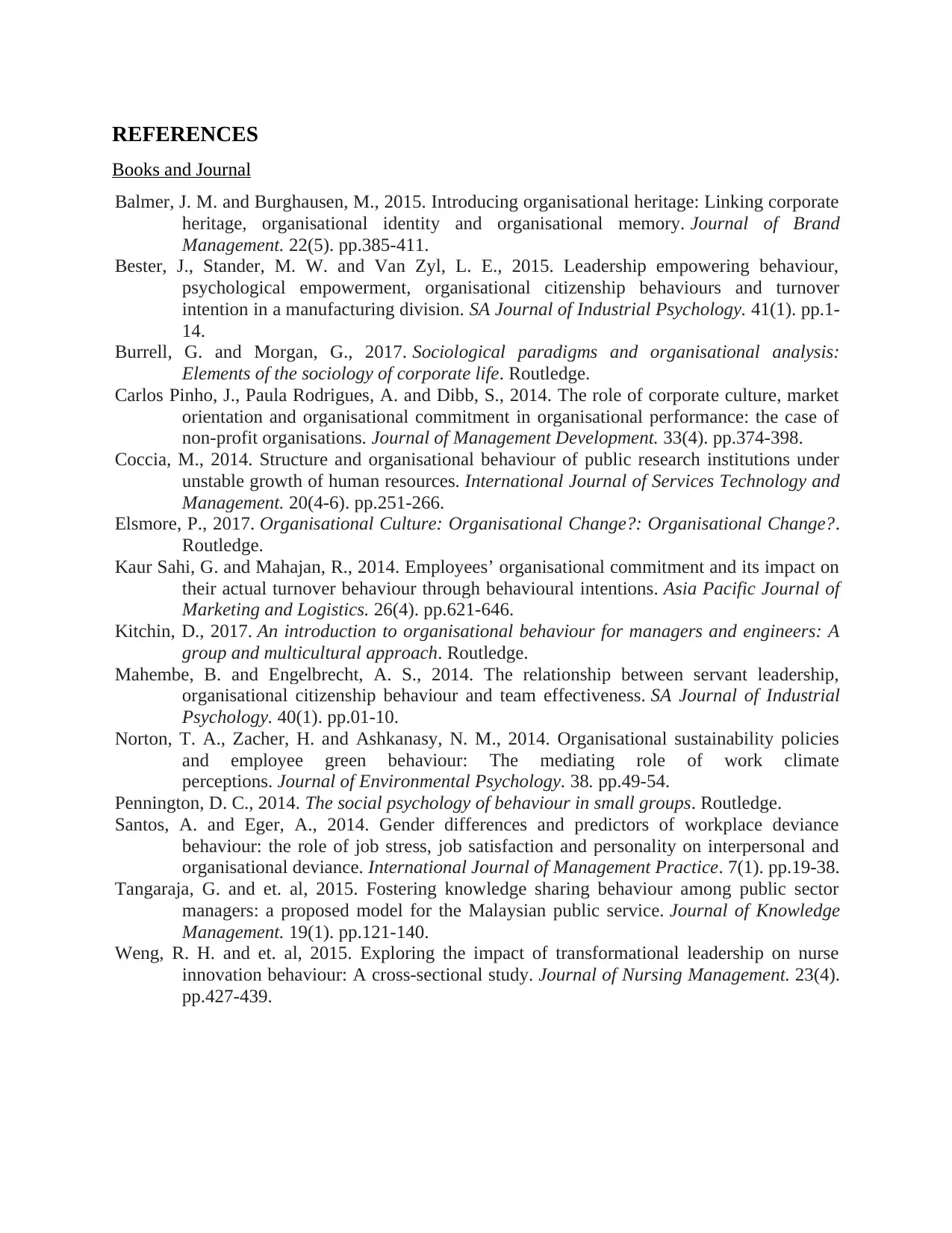
REFERENCES
Books and Journal
Balmer, J. M. and Burghausen, M., 2015. Introducing organisational heritage: Linking corporate
heritage, organisational identity and organisational memory. Journal of Brand
Management. 22(5). pp.385-411.
Bester, J., Stander, M. W. and Van Zyl, L. E., 2015. Leadership empowering behaviour,
psychological empowerment, organisational citizenship behaviours and turnover
intention in a manufacturing division. SA Journal of Industrial Psychology. 41(1). pp.1-
14.
Burrell, G. and Morgan, G., 2017. Sociological paradigms and organisational analysis:
Elements of the sociology of corporate life. Routledge.
Carlos Pinho, J., Paula Rodrigues, A. and Dibb, S., 2014. The role of corporate culture, market
orientation and organisational commitment in organisational performance: the case of
non-profit organisations. Journal of Management Development. 33(4). pp.374-398.
Coccia, M., 2014. Structure and organisational behaviour of public research institutions under
unstable growth of human resources. International Journal of Services Technology and
Management. 20(4-6). pp.251-266.
Elsmore, P., 2017. Organisational Culture: Organisational Change?: Organisational Change?.
Routledge.
Kaur Sahi, G. and Mahajan, R., 2014. Employees’ organisational commitment and its impact on
their actual turnover behaviour through behavioural intentions. Asia Pacific Journal of
Marketing and Logistics. 26(4). pp.621-646.
Kitchin, D., 2017. An introduction to organisational behaviour for managers and engineers: A
group and multicultural approach. Routledge.
Mahembe, B. and Engelbrecht, A. S., 2014. The relationship between servant leadership,
organisational citizenship behaviour and team effectiveness. SA Journal of Industrial
Psychology. 40(1). pp.01-10.
Norton, T. A., Zacher, H. and Ashkanasy, N. M., 2014. Organisational sustainability policies
and employee green behaviour: The mediating role of work climate
perceptions. Journal of Environmental Psychology. 38. pp.49-54.
Pennington, D. C., 2014. The social psychology of behaviour in small groups. Routledge.
Santos, A. and Eger, A., 2014. Gender differences and predictors of workplace deviance
behaviour: the role of job stress, job satisfaction and personality on interpersonal and
organisational deviance. International Journal of Management Practice. 7(1). pp.19-38.
Tangaraja, G. and et. al, 2015. Fostering knowledge sharing behaviour among public sector
managers: a proposed model for the Malaysian public service. Journal of Knowledge
Management. 19(1). pp.121-140.
Weng, R. H. and et. al, 2015. Exploring the impact of transformational leadership on nurse
innovation behaviour: A cross‐sectional study. Journal of Nursing Management. 23(4).
pp.427-439.
Books and Journal
Balmer, J. M. and Burghausen, M., 2015. Introducing organisational heritage: Linking corporate
heritage, organisational identity and organisational memory. Journal of Brand
Management. 22(5). pp.385-411.
Bester, J., Stander, M. W. and Van Zyl, L. E., 2015. Leadership empowering behaviour,
psychological empowerment, organisational citizenship behaviours and turnover
intention in a manufacturing division. SA Journal of Industrial Psychology. 41(1). pp.1-
14.
Burrell, G. and Morgan, G., 2017. Sociological paradigms and organisational analysis:
Elements of the sociology of corporate life. Routledge.
Carlos Pinho, J., Paula Rodrigues, A. and Dibb, S., 2014. The role of corporate culture, market
orientation and organisational commitment in organisational performance: the case of
non-profit organisations. Journal of Management Development. 33(4). pp.374-398.
Coccia, M., 2014. Structure and organisational behaviour of public research institutions under
unstable growth of human resources. International Journal of Services Technology and
Management. 20(4-6). pp.251-266.
Elsmore, P., 2017. Organisational Culture: Organisational Change?: Organisational Change?.
Routledge.
Kaur Sahi, G. and Mahajan, R., 2014. Employees’ organisational commitment and its impact on
their actual turnover behaviour through behavioural intentions. Asia Pacific Journal of
Marketing and Logistics. 26(4). pp.621-646.
Kitchin, D., 2017. An introduction to organisational behaviour for managers and engineers: A
group and multicultural approach. Routledge.
Mahembe, B. and Engelbrecht, A. S., 2014. The relationship between servant leadership,
organisational citizenship behaviour and team effectiveness. SA Journal of Industrial
Psychology. 40(1). pp.01-10.
Norton, T. A., Zacher, H. and Ashkanasy, N. M., 2014. Organisational sustainability policies
and employee green behaviour: The mediating role of work climate
perceptions. Journal of Environmental Psychology. 38. pp.49-54.
Pennington, D. C., 2014. The social psychology of behaviour in small groups. Routledge.
Santos, A. and Eger, A., 2014. Gender differences and predictors of workplace deviance
behaviour: the role of job stress, job satisfaction and personality on interpersonal and
organisational deviance. International Journal of Management Practice. 7(1). pp.19-38.
Tangaraja, G. and et. al, 2015. Fostering knowledge sharing behaviour among public sector
managers: a proposed model for the Malaysian public service. Journal of Knowledge
Management. 19(1). pp.121-140.
Weng, R. H. and et. al, 2015. Exploring the impact of transformational leadership on nurse
innovation behaviour: A cross‐sectional study. Journal of Nursing Management. 23(4).
pp.427-439.
⊘ This is a preview!⊘
Do you want full access?
Subscribe today to unlock all pages.

Trusted by 1+ million students worldwide
1 out of 12
Related Documents
Your All-in-One AI-Powered Toolkit for Academic Success.
+13062052269
info@desklib.com
Available 24*7 on WhatsApp / Email
![[object Object]](/_next/static/media/star-bottom.7253800d.svg)
Unlock your academic potential
Copyright © 2020–2025 A2Z Services. All Rights Reserved. Developed and managed by ZUCOL.




